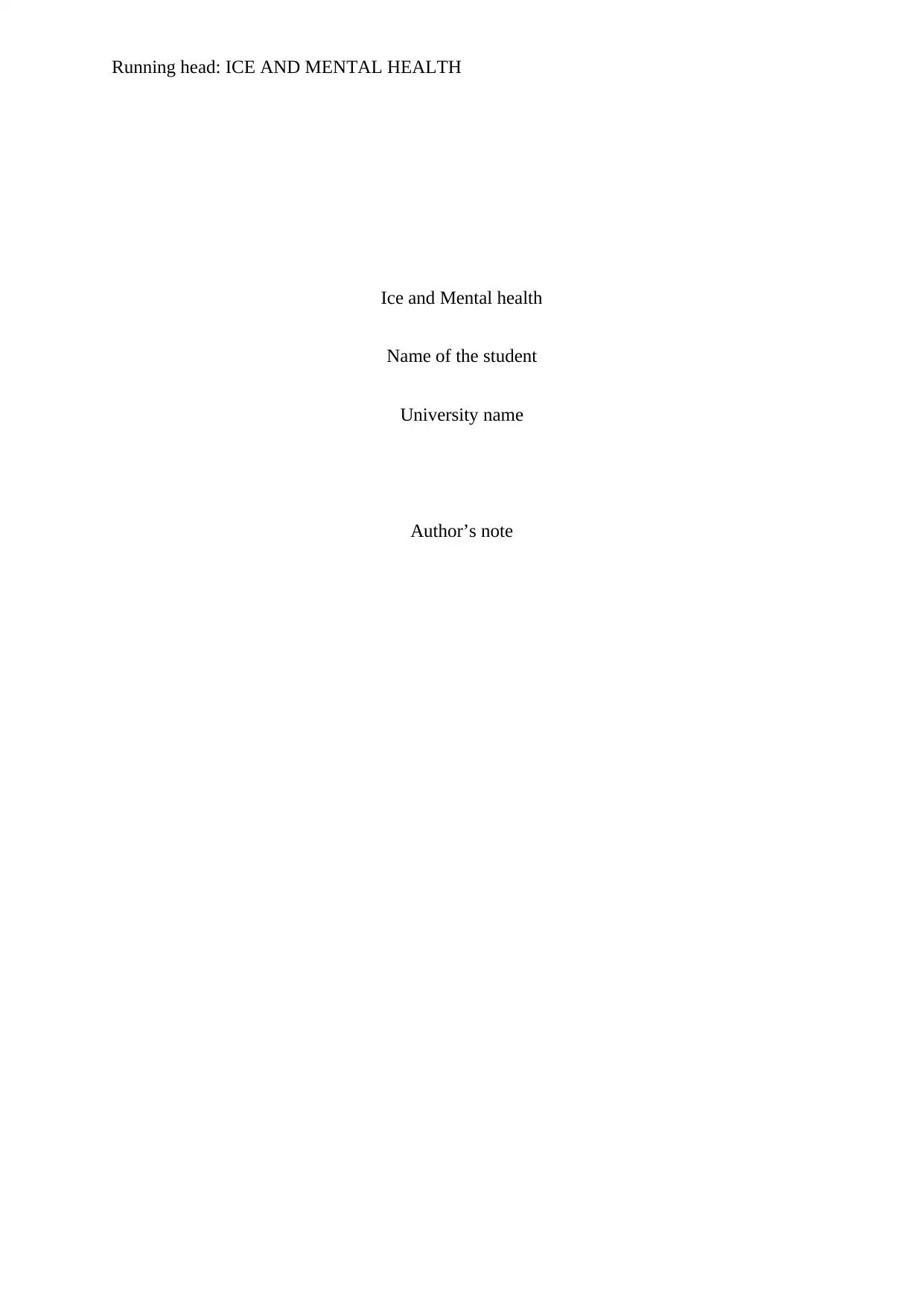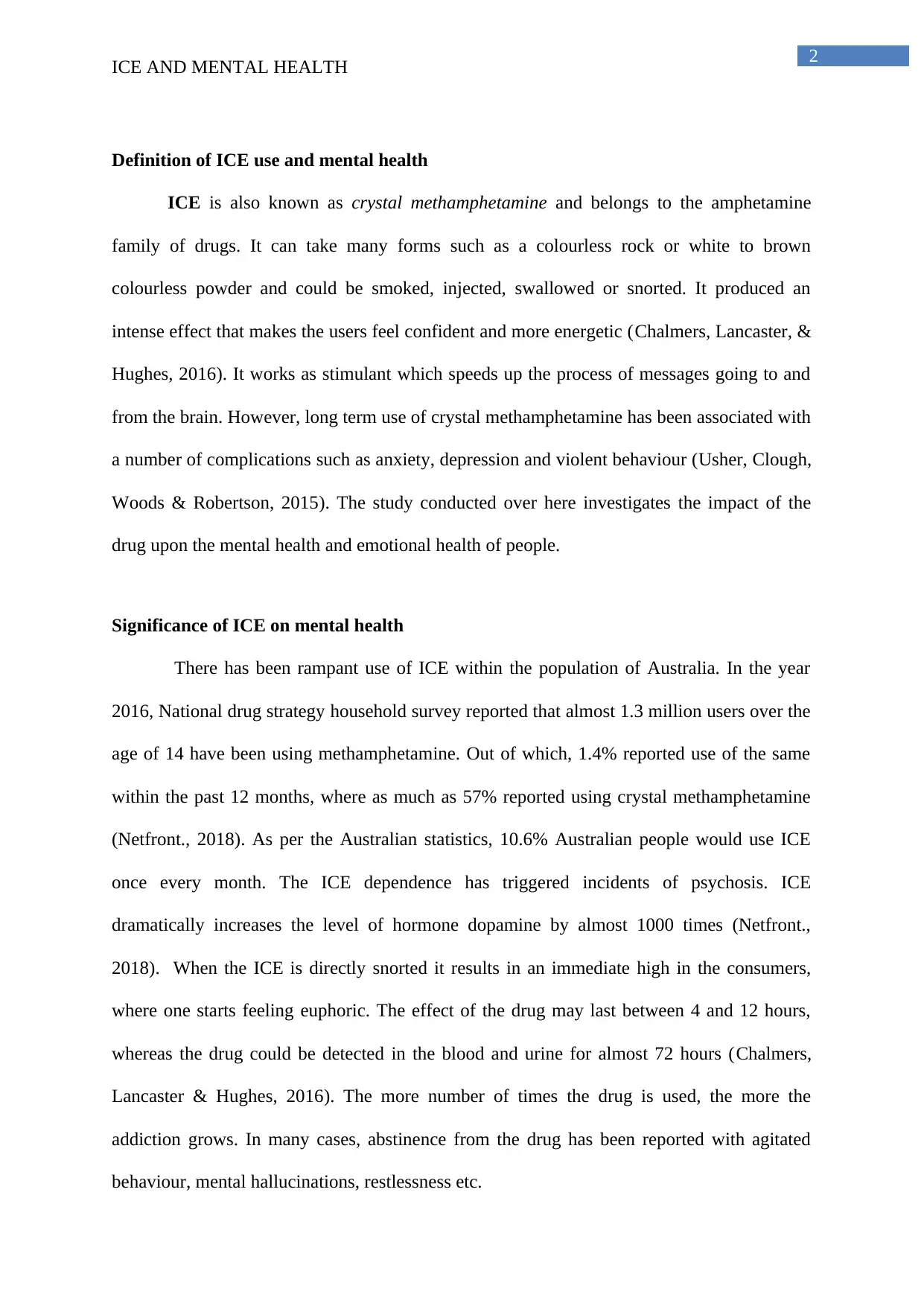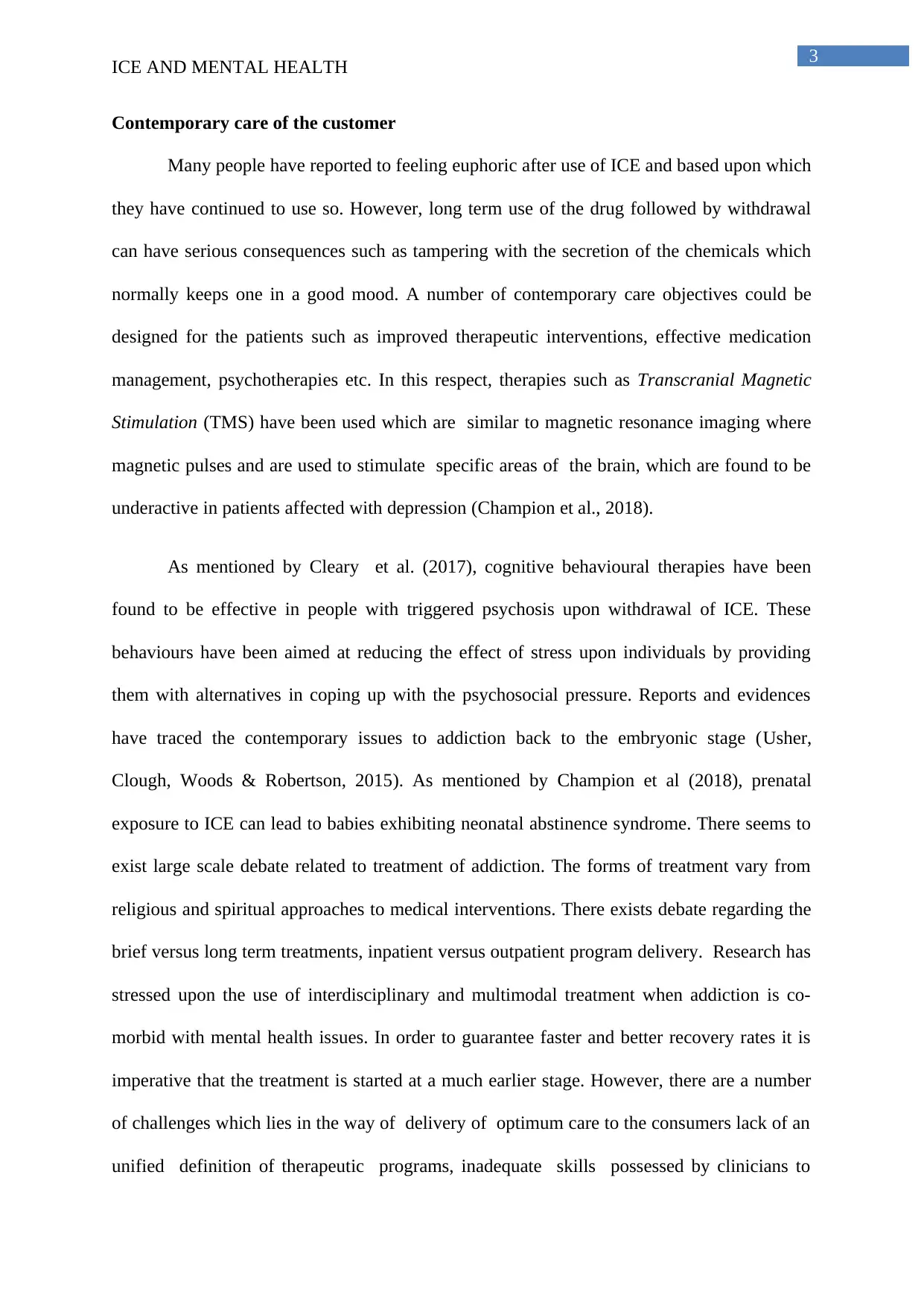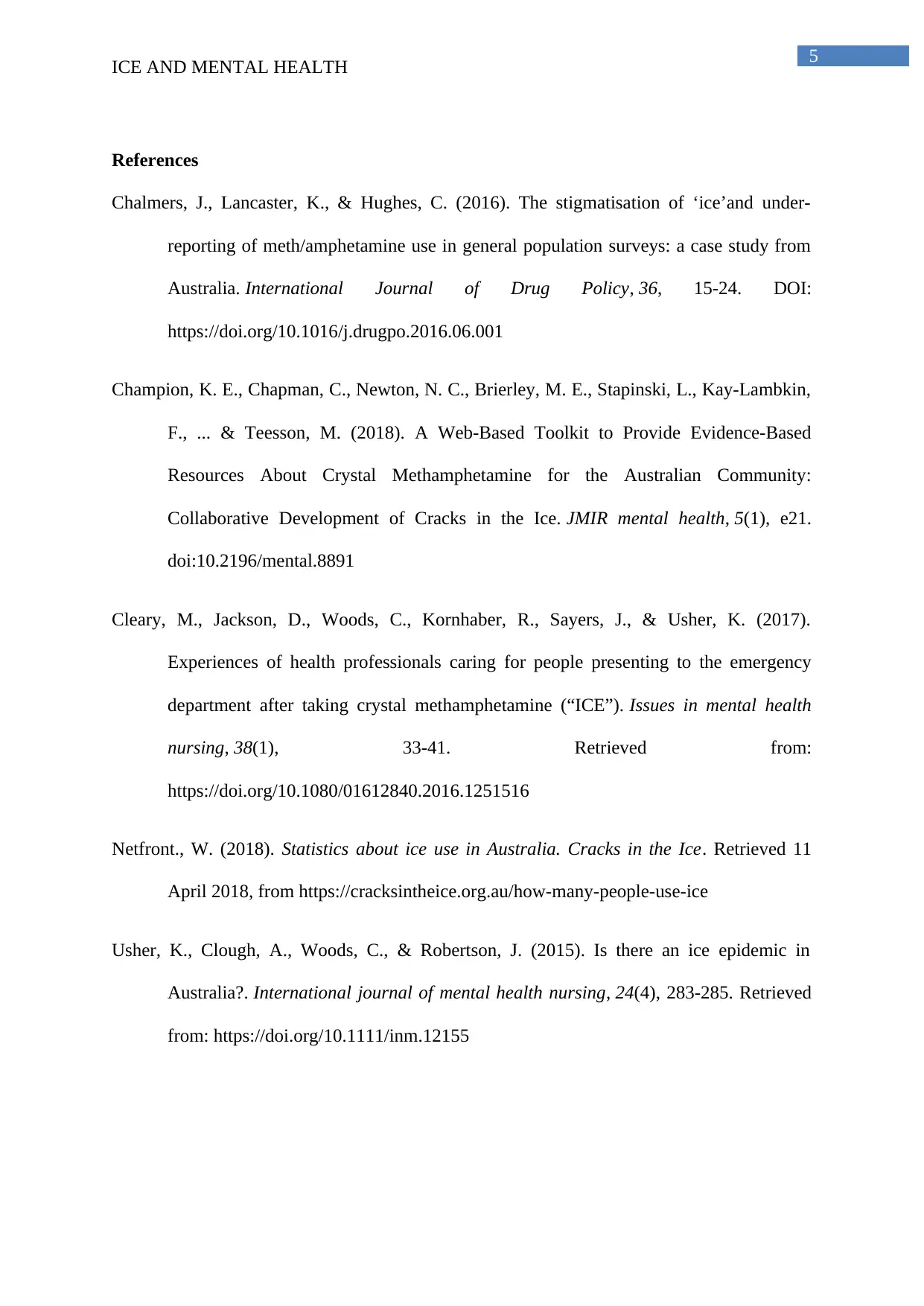Exploring the Impact of ICE Use on Mental Health and Contemporary Care
VerifiedAdded on 2023/06/13
|6
|1122
|297
Report
AI Summary
This report examines the relationship between ICE (crystal methamphetamine) use and mental health, highlighting the drug's impact on users, including potential complications like anxiety, depression, and violent behavior. It discusses the prevalence of ICE use in Australia and its association with psychosis due to increased dopamine levels. The report further explores contemporary care objectives, such as therapeutic interventions like Transcranial Magnetic Stimulation (TMS) and cognitive behavioral therapies, for individuals struggling with ICE addiction. It also addresses challenges in delivering optimal care, including the need for unified therapeutic programs and skilled clinicians. This document is available on Desklib, where students can find a wealth of study resources including past papers and solved assignments.

Running head: ICE AND MENTAL HEALTH
Ice and Mental health
Name of the student
University name
Author’s note
Ice and Mental health
Name of the student
University name
Author’s note
Paraphrase This Document
Need a fresh take? Get an instant paraphrase of this document with our AI Paraphraser

1
ICE AND MENTAL HEALTH
Table of Contents
Definition of ICE use and mental health....................................................................................2
Significance of ICE on mental health........................................................................................2
Contemporary care of the customer...........................................................................................3
References..................................................................................................................................5
ICE AND MENTAL HEALTH
Table of Contents
Definition of ICE use and mental health....................................................................................2
Significance of ICE on mental health........................................................................................2
Contemporary care of the customer...........................................................................................3
References..................................................................................................................................5

2
ICE AND MENTAL HEALTH
Definition of ICE use and mental health
ICE is also known as crystal methamphetamine and belongs to the amphetamine
family of drugs. It can take many forms such as a colourless rock or white to brown
colourless powder and could be smoked, injected, swallowed or snorted. It produced an
intense effect that makes the users feel confident and more energetic (Chalmers, Lancaster, &
Hughes, 2016). It works as stimulant which speeds up the process of messages going to and
from the brain. However, long term use of crystal methamphetamine has been associated with
a number of complications such as anxiety, depression and violent behaviour (Usher, Clough,
Woods & Robertson, 2015). The study conducted over here investigates the impact of the
drug upon the mental health and emotional health of people.
Significance of ICE on mental health
There has been rampant use of ICE within the population of Australia. In the year
2016, National drug strategy household survey reported that almost 1.3 million users over the
age of 14 have been using methamphetamine. Out of which, 1.4% reported use of the same
within the past 12 months, where as much as 57% reported using crystal methamphetamine
(Netfront., 2018). As per the Australian statistics, 10.6% Australian people would use ICE
once every month. The ICE dependence has triggered incidents of psychosis. ICE
dramatically increases the level of hormone dopamine by almost 1000 times (Netfront.,
2018). When the ICE is directly snorted it results in an immediate high in the consumers,
where one starts feeling euphoric. The effect of the drug may last between 4 and 12 hours,
whereas the drug could be detected in the blood and urine for almost 72 hours (Chalmers,
Lancaster & Hughes, 2016). The more number of times the drug is used, the more the
addiction grows. In many cases, abstinence from the drug has been reported with agitated
behaviour, mental hallucinations, restlessness etc.
ICE AND MENTAL HEALTH
Definition of ICE use and mental health
ICE is also known as crystal methamphetamine and belongs to the amphetamine
family of drugs. It can take many forms such as a colourless rock or white to brown
colourless powder and could be smoked, injected, swallowed or snorted. It produced an
intense effect that makes the users feel confident and more energetic (Chalmers, Lancaster, &
Hughes, 2016). It works as stimulant which speeds up the process of messages going to and
from the brain. However, long term use of crystal methamphetamine has been associated with
a number of complications such as anxiety, depression and violent behaviour (Usher, Clough,
Woods & Robertson, 2015). The study conducted over here investigates the impact of the
drug upon the mental health and emotional health of people.
Significance of ICE on mental health
There has been rampant use of ICE within the population of Australia. In the year
2016, National drug strategy household survey reported that almost 1.3 million users over the
age of 14 have been using methamphetamine. Out of which, 1.4% reported use of the same
within the past 12 months, where as much as 57% reported using crystal methamphetamine
(Netfront., 2018). As per the Australian statistics, 10.6% Australian people would use ICE
once every month. The ICE dependence has triggered incidents of psychosis. ICE
dramatically increases the level of hormone dopamine by almost 1000 times (Netfront.,
2018). When the ICE is directly snorted it results in an immediate high in the consumers,
where one starts feeling euphoric. The effect of the drug may last between 4 and 12 hours,
whereas the drug could be detected in the blood and urine for almost 72 hours (Chalmers,
Lancaster & Hughes, 2016). The more number of times the drug is used, the more the
addiction grows. In many cases, abstinence from the drug has been reported with agitated
behaviour, mental hallucinations, restlessness etc.
⊘ This is a preview!⊘
Do you want full access?
Subscribe today to unlock all pages.

Trusted by 1+ million students worldwide

3
ICE AND MENTAL HEALTH
Contemporary care of the customer
Many people have reported to feeling euphoric after use of ICE and based upon which
they have continued to use so. However, long term use of the drug followed by withdrawal
can have serious consequences such as tampering with the secretion of the chemicals which
normally keeps one in a good mood. A number of contemporary care objectives could be
designed for the patients such as improved therapeutic interventions, effective medication
management, psychotherapies etc. In this respect, therapies such as Transcranial Magnetic
Stimulation (TMS) have been used which are similar to magnetic resonance imaging where
magnetic pulses and are used to stimulate specific areas of the brain, which are found to be
underactive in patients affected with depression (Champion et al., 2018).
As mentioned by Cleary et al. (2017), cognitive behavioural therapies have been
found to be effective in people with triggered psychosis upon withdrawal of ICE. These
behaviours have been aimed at reducing the effect of stress upon individuals by providing
them with alternatives in coping up with the psychosocial pressure. Reports and evidences
have traced the contemporary issues to addiction back to the embryonic stage (Usher,
Clough, Woods & Robertson, 2015). As mentioned by Champion et al (2018), prenatal
exposure to ICE can lead to babies exhibiting neonatal abstinence syndrome. There seems to
exist large scale debate related to treatment of addiction. The forms of treatment vary from
religious and spiritual approaches to medical interventions. There exists debate regarding the
brief versus long term treatments, inpatient versus outpatient program delivery. Research has
stressed upon the use of interdisciplinary and multimodal treatment when addiction is co-
morbid with mental health issues. In order to guarantee faster and better recovery rates it is
imperative that the treatment is started at a much earlier stage. However, there are a number
of challenges which lies in the way of delivery of optimum care to the consumers lack of an
unified definition of therapeutic programs, inadequate skills possessed by clinicians to
ICE AND MENTAL HEALTH
Contemporary care of the customer
Many people have reported to feeling euphoric after use of ICE and based upon which
they have continued to use so. However, long term use of the drug followed by withdrawal
can have serious consequences such as tampering with the secretion of the chemicals which
normally keeps one in a good mood. A number of contemporary care objectives could be
designed for the patients such as improved therapeutic interventions, effective medication
management, psychotherapies etc. In this respect, therapies such as Transcranial Magnetic
Stimulation (TMS) have been used which are similar to magnetic resonance imaging where
magnetic pulses and are used to stimulate specific areas of the brain, which are found to be
underactive in patients affected with depression (Champion et al., 2018).
As mentioned by Cleary et al. (2017), cognitive behavioural therapies have been
found to be effective in people with triggered psychosis upon withdrawal of ICE. These
behaviours have been aimed at reducing the effect of stress upon individuals by providing
them with alternatives in coping up with the psychosocial pressure. Reports and evidences
have traced the contemporary issues to addiction back to the embryonic stage (Usher,
Clough, Woods & Robertson, 2015). As mentioned by Champion et al (2018), prenatal
exposure to ICE can lead to babies exhibiting neonatal abstinence syndrome. There seems to
exist large scale debate related to treatment of addiction. The forms of treatment vary from
religious and spiritual approaches to medical interventions. There exists debate regarding the
brief versus long term treatments, inpatient versus outpatient program delivery. Research has
stressed upon the use of interdisciplinary and multimodal treatment when addiction is co-
morbid with mental health issues. In order to guarantee faster and better recovery rates it is
imperative that the treatment is started at a much earlier stage. However, there are a number
of challenges which lies in the way of delivery of optimum care to the consumers lack of an
unified definition of therapeutic programs, inadequate skills possessed by clinicians to
Paraphrase This Document
Need a fresh take? Get an instant paraphrase of this document with our AI Paraphraser

4
ICE AND MENTAL HEALTH
work with addicts (Usher, Clough, Woods & Robertson, 2015). TMs therapies along with
psychological support have been effective in reducing the perils of ICE dependence upon the
addicts.
ICE AND MENTAL HEALTH
work with addicts (Usher, Clough, Woods & Robertson, 2015). TMs therapies along with
psychological support have been effective in reducing the perils of ICE dependence upon the
addicts.

5
ICE AND MENTAL HEALTH
References
Chalmers, J., Lancaster, K., & Hughes, C. (2016). The stigmatisation of ‘ice’and under-
reporting of meth/amphetamine use in general population surveys: a case study from
Australia. International Journal of Drug Policy, 36, 15-24. DOI:
https://doi.org/10.1016/j.drugpo.2016.06.001
Champion, K. E., Chapman, C., Newton, N. C., Brierley, M. E., Stapinski, L., Kay-Lambkin,
F., ... & Teesson, M. (2018). A Web-Based Toolkit to Provide Evidence-Based
Resources About Crystal Methamphetamine for the Australian Community:
Collaborative Development of Cracks in the Ice. JMIR mental health, 5(1), e21.
doi:10.2196/mental.8891
Cleary, M., Jackson, D., Woods, C., Kornhaber, R., Sayers, J., & Usher, K. (2017).
Experiences of health professionals caring for people presenting to the emergency
department after taking crystal methamphetamine (“ICE”). Issues in mental health
nursing, 38(1), 33-41. Retrieved from:
https://doi.org/10.1080/01612840.2016.1251516
Netfront., W. (2018). Statistics about ice use in Australia. Cracks in the Ice. Retrieved 11
April 2018, from https://cracksintheice.org.au/how-many-people-use-ice
Usher, K., Clough, A., Woods, C., & Robertson, J. (2015). Is there an ice epidemic in
Australia?. International journal of mental health nursing, 24(4), 283-285. Retrieved
from: https://doi.org/10.1111/inm.12155
ICE AND MENTAL HEALTH
References
Chalmers, J., Lancaster, K., & Hughes, C. (2016). The stigmatisation of ‘ice’and under-
reporting of meth/amphetamine use in general population surveys: a case study from
Australia. International Journal of Drug Policy, 36, 15-24. DOI:
https://doi.org/10.1016/j.drugpo.2016.06.001
Champion, K. E., Chapman, C., Newton, N. C., Brierley, M. E., Stapinski, L., Kay-Lambkin,
F., ... & Teesson, M. (2018). A Web-Based Toolkit to Provide Evidence-Based
Resources About Crystal Methamphetamine for the Australian Community:
Collaborative Development of Cracks in the Ice. JMIR mental health, 5(1), e21.
doi:10.2196/mental.8891
Cleary, M., Jackson, D., Woods, C., Kornhaber, R., Sayers, J., & Usher, K. (2017).
Experiences of health professionals caring for people presenting to the emergency
department after taking crystal methamphetamine (“ICE”). Issues in mental health
nursing, 38(1), 33-41. Retrieved from:
https://doi.org/10.1080/01612840.2016.1251516
Netfront., W. (2018). Statistics about ice use in Australia. Cracks in the Ice. Retrieved 11
April 2018, from https://cracksintheice.org.au/how-many-people-use-ice
Usher, K., Clough, A., Woods, C., & Robertson, J. (2015). Is there an ice epidemic in
Australia?. International journal of mental health nursing, 24(4), 283-285. Retrieved
from: https://doi.org/10.1111/inm.12155
⊘ This is a preview!⊘
Do you want full access?
Subscribe today to unlock all pages.

Trusted by 1+ million students worldwide
1 out of 6
Your All-in-One AI-Powered Toolkit for Academic Success.
+13062052269
info@desklib.com
Available 24*7 on WhatsApp / Email
![[object Object]](/_next/static/media/star-bottom.7253800d.svg)
Unlock your academic potential
Copyright © 2020–2025 A2Z Services. All Rights Reserved. Developed and managed by ZUCOL.

